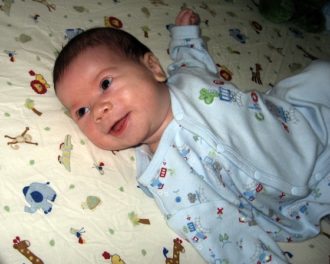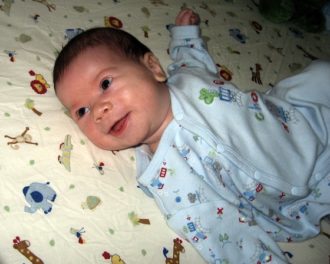
New parents never lack for reasons to be afraid. And they have some justification: Unlike many animals, whose young can walk or swim within hours, children remain defenseless and vulnerable for years.
Polio was the nightmare of parents for generations. But in the 1980s, parents were gripped by a new fear: An apparently healthy baby might go to sleep and never wake up.
There was no easy explanation for overnight infant deaths. Panic mounted among the public, and government agencies began counting cases of the mysterious baby killer, which they soon named SIDS, or Sudden Infant Death Syndrome.
The Centers for Disease Control and Prevention defined SIDS as the sudden death of an infant less than 1 year old that could not be explained after an autopsy, review of the baby’s medical history, and examination of the death scene.
Medical investigators looked for congenital abnormalities, environmental factors and new infections that could explain the sudden deaths of so many babies.
Instead, investigations by medical examiners and coroners yielded a more conventional explanation in most cases. Most of these infants died due to unsafe practices that professionals had been warning against for years, including putting babies to sleep on their stomachs and leaving toys and blankets near enough to sleeping babies to cause strangulation or smothering,
Since 1998, infant deaths that once would have been called SIDS have increasingly been attributed to unsafe sleeping conditions.
(SIDS still exists as a diagnosis in rare cases. When there is no clear evidence of a definable cause of death — such as unsafe sleeping conditions, negligence, foul play or a medical problem — the death is ruled SIDS.)
In 2009, 141 of 199 deaths among Georgia infants less than 1 year old were sleep-related, according to a statewide review of fatalities among children.
Ironically, the most dangerous place for a sleeping baby is the parents’ supposedly safe bed. Co-sleeping, also called bed sharing, is the leading cause of sleep-related infant deaths in Georgia.
For babies 3 to 4 months old, co-sleeping is more lethal than any disease or injury, according to the Georgia Department of Human Services.
Some traditions are dangerous
It appears that the fixation on SIDS as a mystery illness may have deflected attention from preventable problems that led to a steady loss of young lives.
Fortunately, prevention of the most common causes of infant death is not difficult or complicated.
“A baby needs a safe place to sleep,” says Dr. Michael Goodstein of York, Pa., who’s a neonatologist at York Hospital and director of York County Cribs.
The American Academy of Pediatrics (AAP) advises against co-sleeping, which can put an infant at risk of suffocation and strangulation. It recommends that babies sleep in the same bedroom as their parents, but in a separate crib or bassinet, for the first few months of life.
Parents who advocate co-sleeping say sharing a bed with their infant allows for bonding and convenient feedings.
“Mothers can cuddle and nurse their babies in the adult bed,” says Goodstein. “But they need to be aware that when the parent is getting drowsy, it’s time for the baby to be put back in a proximate but separate safe-sleep environment.’’
Some parents choose to co-sleep because of tradition or family pressure.
“Part of the problem is, people are just all too happy to include their thoughts on taking care of a baby when you are a new parent,” Goodstein says.
New parents are bombarded with conflicting advice about where and how babies should sleep. Magazines, TV shows, health care providers, relatives and friends all want to have their say.
“Unfortunately there are conflicting messages as a norm, and that makes it very difficult for a family to know what to do,” Goodstein says.
Daphne Barbow of Georgia’s Maternal and Child Health Program says, “Mothers will say things like, ‘I slept on my stomach [as a baby]’ or ‘My mom slept with me,’ so they are doing things from their own personal experience.”
Babies should sleep face up
Although experts agree that a crib is the safest place for an infant to sleep, not every family can afford one. In that case, the AAP recommends substituting a dresser drawer that has been removed from the dresser.
When it’s time for babies to sleep, they should be placed on their backs, and there should be no soft objects, toys or loose bedding within reach.
The Maternal and Child Health Program, part of the Department of Public Health, offers education and training programs for parents regarding safe sleeping conditions for infants. It also provides free cribs to some Georgia social services agencies, and families that meet certain income criteria are eligible to get them.
Due to budget cuts, though, statewide funding devoted to infant sleep safety has been reduced.
“So many of the counties have taken on safe-sleep initiatives and they have developed their own prevention programs,” says Wendy Parker, program manager at the Georgia Office of the Child Advocate.
Child safety advocates point to the infant car seat program as an ideal model for sleep safety. Hospitals discharge newborns only when parents have a car seat and have it installed. The same thing could happen with cribs, child advocates say.
“Infant sleep safety requires a consistent and repetitive message in the community to prevent accidental deaths,” Goodstein says.
Some hospitals advise parents about sleep safety when newborns and their mothers are being discharged, but too often this advice takes a backseat to less important information.
“I’ve never seen a baby come back to my emergency department who has died because their bath wasn’t perfect and they had some dirt behind their ears,” Goodstein says. “But I’ve seen lots of babies come back dead because parents didn’t know how to ‘sleep’ their babies safely.”

